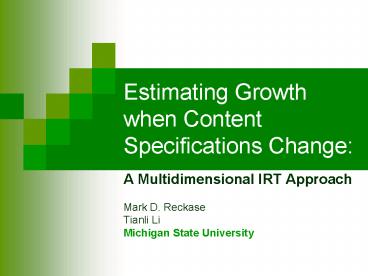Estimating Growth when Content Specifications Change: - PowerPoint PPT Presentation
1 / 26
Title:
Estimating Growth when Content Specifications Change:
Description:
Problem Solving. Algebra. Simulated Test Structure. 40 (10) 18 (6) 11 (4) 11 (0) Grade 7 ... Problem Solving. Arithmetic. Algebra. Test Level ... – PowerPoint PPT presentation
Number of Views:22
Avg rating:3.0/5.0
Title: Estimating Growth when Content Specifications Change:
1
Estimating Growth when Content Specifications
Change
- A Multidimensional IRT Approach
- Mark D. Reckase
- Tianli Li
- Michigan State University
2
The Problem
- State curriculum frameworks often change from one
grade to the next reflecting the addition of new
instructional content. - For example, at grade 7 algebra may be introduced
as an instructional goal. - At grade 6, algebra is not an important component
of the curriculum. - Tests at the two grades reflect the instructional
content so the 6th grade test does not include
algebra and the 7th grade test does. - How can the score scales of these tests be linked?
3
Research Questions
- What do changes on the linked score scale mean,
when the scale is produced using the usual
unidimensional IRT models? - Can multidimensional IRT be used to form vertical
scales? If so, how do the results compare to the
unidimensional results?
4
The Approach
- State testing data were analyzed using
multidimensional IRT to develop a realistic model
for the test data at two grade levels. - The results of the real data analyses were
idealized to create the specifications for
simulating the tests at two grade levels. - Simulate data with known structure to determine
how unidimensional and multidimensional
procedures function.
5
The Simulated Data Design
- Grade 6 two major constructs
- Arithmetic
- Problem Solving
- Grade 7 three major constructs
- Arithmetic
- Problem Solving
- Algebra
6
Simulated Test Structure
Note The numbers in parentheses are the common
items between the two forms of the tests.
7
Mean Vectors at each Grade Level
Note Values in parentheses are the observed
means from the simulated data
8
Covariance Matrices
Covariance Matrix for Grade 6
Covariance Matrix for Grade 7
Note Values in parentheses are estimated from
the simulated data.
9
Orientation of Items
10
Effect Size Built into Data
11
Unidimensional Basisfor Comparison
- Imagine that the full set of 70 items from both
test levels are administered to the students at
both grade levels. - The matrix of 2000 2000 students from the two
grades by 70 items can be analyzed with the
unidimensional models to serve as a basis for
comparison for the vertical scaling result. - Analyze the matrix using 2pl and Rasch model.
12
2PL Solution
13
Rasch Model Solution
14
Vertical Scaling Analysis
- Common-item concurrent calibration
- BILOGMG
- Off grade items coded as not reached
- Both 2pl and Rasch model used for analysis
- Determine effect size of difference in mean of
two grade levels
15
Vertically Scaled Effect Sizes
16
Vertically Scaled Effect Sizes
- Linked effect size is smaller than full data
effect size. - Rasch effect size is less than 2pl effect size.
- Full data set effect size is less than modeled
effect size.
17
Alternative Linking Method
- Common-item, separate calibration
- Common item parameter relationship was poor
18
MIRT Analysis
- Full data analysis with TESTFACT
- Three dimensional analysis
- Determine effect size for each dimension
- Correlate each estimated q with the generating qs
to determine meaning of the results.
19
MIRT Effect Sizes
20
Correlation between Trueand Estimated q Values
21
Interpretation of MIRT Solution
- Results are difficult to interpret because of the
default procedures in TESTFACT. - Solution needs to be rotated to have axes align
with content dimensions. - Current solution shows that q1 is related to
algebra and shows the big algebra effect. - q2 is a combination of arithmetic and problem
solving with the emphasis on problem solving. - Most likely it has the sign of the a-parameters
reversed.
22
Concurrent MIRT Analysis
- Use concurrent calibration of data from the two
grade levels. - Three dimensional solution
- No rotation
- Determine effect sizes and correlations with true
q values.
23
Concurrent MIRT Calibration
24
Concurrent MIRT Calibration
25
Concurrent MIRT Calibration
- Scale on Dimension 3 is reversed and it has a
large effect size (algebra). - Dimension 1 is most related to arithmetic and
problem solving with a moderate effect size. - Dimension 2 is moderately related to algebra and
has a large effect size. - The overall result gives a reasonable estimate of
effects, but the dimensions need to be rotated to
match the constructs.
26
Conclusions
- Unidimensional linking of the two level tests
underestimate the effect size. - Rasch model gives a smaller effect size than the
two parameter logistic model. - MIRT solution shows promise.
- Need to determine how to rotate solution to match
constructs. - TESTFACT has problems converging on estimates
because of mismatch between assumptions and
reality.































